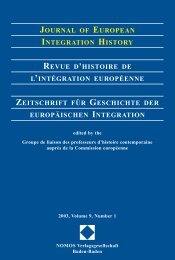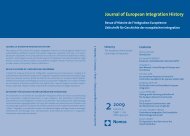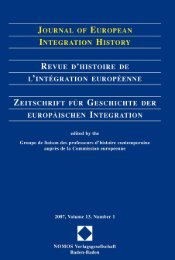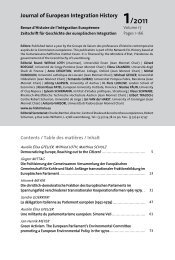journal of european integration history revue d'histoire de l ...
journal of european integration history revue d'histoire de l ...
journal of european integration history revue d'histoire de l ...
Create successful ePaper yourself
Turn your PDF publications into a flip-book with our unique Google optimized e-Paper software.
Book reviews – Comptes rendus – Buchbesprechungen 131<br />
Guido THIEMEYER. – Vom ‘Pool Vert’ zur Europäischen Wirtschaftsgemeinschaft.<br />
Europäische Integration, Kalter Krieg und die Anfänge <strong>de</strong>r Gemeinsamen Europäischen<br />
Agrarpolitik. 1950-1957. Ol<strong>de</strong>nburg Verlag, München, 1999, 300 S. – ISBN 3-486-56427-7. –<br />
148,00 DM.<br />
Un<strong>de</strong>rstanding how agriculture entered the post-war quest for institution building in Western<br />
Europe is not an easy task, particularly in the light <strong>of</strong> intensive state intervention into the sector,<br />
and dominant national agricultural political elites. Nonetheless, this is the question which the<br />
German historian Guido Thiemeyer has pursued in this book, based on his doctoral dissertation.<br />
The book covers a period <strong>of</strong> time that spans from the launching <strong>of</strong> the Green Pool – exploring<br />
both the origins <strong>of</strong> the French Pflimlin Plan and the Dutch Mansholt Plan – to the miserable<br />
breakdown <strong>of</strong> the Green Pool negotiations in 1954. It then proceeds to examine the bilateral<br />
Franco-German tra<strong>de</strong> agreements conclu<strong>de</strong>d in the aftermath, focusing on agriculture. The Benelux<br />
memorandum should be seen as a response to this apparent return to bilateralism, leading to<br />
the Spaak Committee-process and the writing <strong>of</strong> the agricultural chapter <strong>of</strong> the Treaty establishing<br />
the European Economic Community (EEC). It is a period that has been relatively well<br />
researched by historians in general, but so far, there has not existed a coherent study that systematically<br />
explores the position <strong>of</strong> agriculture in the European context; this is where Thiemeyer’s<br />
book enters the scene. Based on thorough archival studies in the French, German and Dutch<br />
central administrations, the book <strong>of</strong>fers a good view <strong>of</strong> the process <strong>of</strong> <strong>de</strong>cision-making that lay<br />
behind the <strong>de</strong>velopment at European level.<br />
The title <strong>of</strong> the book – in English, From ‘Green Pool’ to the European Economic Community.<br />
European Integration, Cold War and the beginnings <strong>of</strong> the Common Agricultural Policy 1950-57 –<br />
suggests the framework within which the study has been conceived. The European <strong>integration</strong> process,<br />
and the importance assigned to agriculture within that process has to be un<strong>de</strong>rstood, so the<br />
argument goes, in the context <strong>of</strong> the way that western European countries were trying to position<br />
themselves during the Cold War. The diplomatic narrative in relation to agriculture in the period<br />
from the Green Pool to the EEC Treaty has been presented several times before (Milward, Griffiths<br />
and Milward, Girvin and Griffiths, Nöel, etc.). Thiemeyer has, nonetheless, carefully gone through<br />
the archival documentation <strong>of</strong> the whole period again, but, at times, leaves the rea<strong>de</strong>r with the<br />
impression that it brings very little new to the un<strong>de</strong>rstanding <strong>of</strong> this part <strong>of</strong> the process. The real<br />
merits <strong>of</strong> the research effort at this level <strong>of</strong> the analysis therefore lie much in what happened<br />
‘in-between’ the big events. For instance the position <strong>of</strong> agriculture in the Franco-German<br />
La-Celle-Saint Cloud negotiations has not been presented this clearly previously, nor has the political<br />
horsetrading that went on during the discussions <strong>of</strong> the European Defence Community (EDC)<br />
with respect to the important role <strong>of</strong> agricultural parliamentarians. This approach leads to a finely<br />
shaped explanation <strong>of</strong> the period which shows that the integrative efforts <strong>of</strong> the west European<br />
countries were not driven by the efforts to find common solutions for the agricultural sector alone.<br />
However, agriculture always hummed in the background, and at several occasions the reception and<br />
passing <strong>of</strong> other European projects in national parliaments <strong>de</strong>pen<strong>de</strong>d on the political tra<strong>de</strong>-<strong>of</strong>fs that<br />
could be ma<strong>de</strong> with the ‘green blocks’ <strong>of</strong> parliamentarians.<br />
Domestic politics therefore play an important role in this story. A central aspect <strong>of</strong> the<br />
book is that it dissects the national administrations, and shows that most <strong>of</strong> the time, the<br />
administrations were split in their opinion on European policy in general, and on the agricultural<br />
aspects <strong>of</strong> it in particular. Interest representation and domination were at stake here,<br />
and Thiemeyer explains well how these issues were at the heart <strong>of</strong> the internal political<br />
power struggles <strong>of</strong> most governments. What <strong>of</strong>ten <strong>de</strong>termined the government position was<br />
which ministry had won the right to be ‘fe<strong>de</strong>rführend’, i.e. to lead the national <strong>de</strong>legation,<br />
and not consensus about what line to take in the European policy. Evi<strong>de</strong>nce <strong>of</strong> such split<br />
administrations has been shown before in literature, but not in such a systematic and coherent<br />
presentation as this book <strong>of</strong>fers.

















